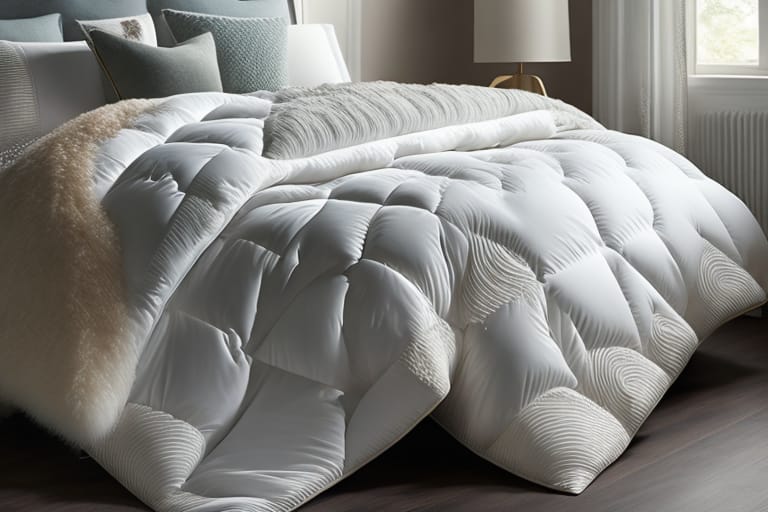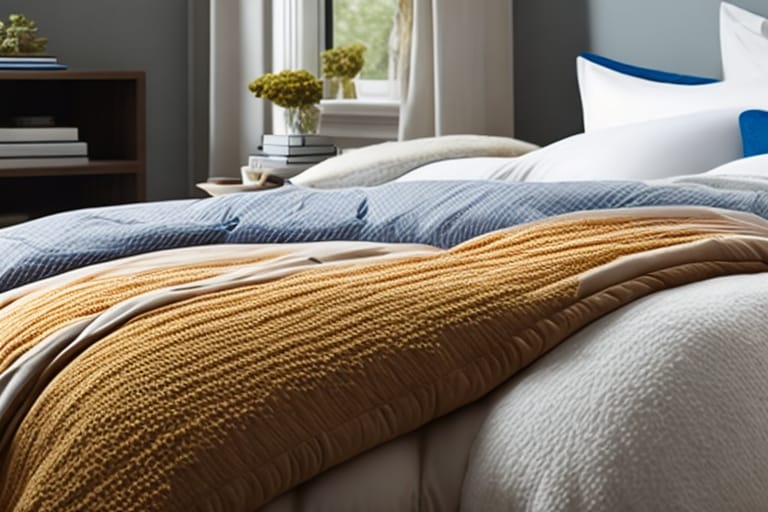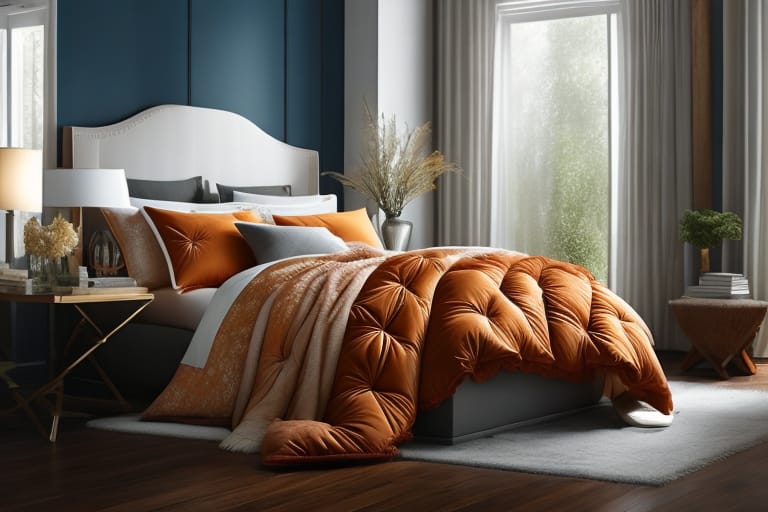Welcome to the fluffiest guide on the internet about one of the most luxurious bedding items you can buy – down comforters. If you’re looking for ultimate warmth and cozy softness to enhance your bed and your sleep quality, down is the way to go.
In this comprehensive article, we’ll explain everything a down comforter beginner needs to know. You’ll learn about:
- The difference between down and down alternative fill
- Important qualities to evaluate when shopping – fill power, construction, shell fabric, ethical sourcing
- Benefits of down – unbeatable softness and insulation
- Care and cleaning recommendations
- And much more to help you select the perfect down comforter!
What is a Down Comforter?
A down comforter consists of the following components:
- Exterior shell – Usually made from lightweight cotton, cotton sateen, or cotton blend fabrics.
- Filling – Goose or duck down mixed with feathers. This provides insulation and loft.
- Construction – Baffle boxes or sewn channels to keep fill evenly distributed.
- Other features – Ties, loops, corner tabs to attach a duvet cover.
High quality down comforters have excellent breathability to keep you comfortable in any season:
- Keep you warm in winter
- Remain cool in summer
Down vs Down Alternative: What’s the Difference?
When shopping for a down comforter, you’ll encounter down alternative options made from polyester or other synthetic fills instead of natural down.
What are the differences?
Down
- Filling made from duck or goose down clusters
- Provides unmatched warmth and softness
- Much higher fill power than down alternative (600-900+ fill power)
- Natural, renewable resource
- More expensive than down alternative
Down Alternative
- Filling typically made from polyester fibers
- Much less expensive than down
- Not as warm or soft as down
- Synthetic fill not biodegradable
- Usually lower fill power
What is Fill Power?
Fill power measures the loft and insulation capability of down or down alternative fill.
Higher fill power = more insulation from fewer ounces of down. 600-900+ fill power is ideal for down comforters.
Down Comforter Benefits
Why choose an authentic down comforter?
- Incomparable softness – Down contains fluffy filaments that cradle you in ultimate comfort. The filling forms to your body for pressure relief.
- 💡 Superior warmth – Down efficiently traps body heat in tiny air pockets created by the cluster structure. Goose down offers the best insulation.
Fill Weight
Fill weight is simply the total weight of the down or down alternative fill inside a comforter, typically measured in ounces. Warmer comforters designed for colder climates need higher fill weights.
- Lightweight – Less than 600 fill power is best for summer or mild climates
- Mid-weight – 600-800 fill power offers versatility for most seasons
- Heavy-weight – Over 800 fill power keeps you cozy warm even in frigid temps
Down comforters have year-round versatility – add a lightweight duvet cover in warmer months.
How to Choose the Best Down Comforter
Ready to select an amazing down comforter? Let’s review key criteria so you know what qualities to evaluate:
1. Fill Material
Choose between goose down or duck down:
- Goose down clusters are slightly larger with better loft. Most premium down bedding contains goose down.
- Duck down offers great performance too – a good option if avoiding goose down (e.g. for religious regions).
- Fill power ranges from 600-900+. Higher = more insulation per ounce.
- Fill weight determines warmth level. Light, medium, or heavy based on your climate needs.
Down proof cotton shell
A tightly-woven 100% cotton shell prevents fill from poking out. 400-600 thread count is ideal. Sateen weave cotton or cotton/sateen blends have a luxuriously smooth finish.
- Texture – Avoid overtly stiff or rough fabric
- Breathability – Allows body heat to dissipate
2. Construction
These 2 methods create fill compartments to keep insulation stable:
Baffle Box
- Preferred construction – forms “pockets” to prevent shifting.
- Promotes maximum loft so down stays evenly distributed.
- Allows customized fill weight per section – feet, body, head.
Sewn Channels
- Less expensive to construct
- Fill shifts more causing cold spots
- Not customized like baffle box sections
3. Thread Count
Pay attention to thread count – number of threads woven per square inch of fabric.
Standard Features
- 300-400 TC = entry level
- 400-600 TC = good mid-range quality
- 600+ TC = ultra-soft luxury sheets
Higher thread count doesn’t always mean better quality – construction and materials matter too.
4. Size
Make sure to get the right size down comforter for your bed! Standard sizes include:
- Twin
- Full/Double
- Queen
- King
Dimensions:
| Size | Dimensions |
|---|---|
| Twin | 66″ W x 86″ L |
| Full/Double | 81″ W x 86″ L |
| Queen | 90″ W x 98″ L |
| King | 106″ W x 98″ L |
Tips:
- Size up for extra comfort and coziness
- Prepare to pay more for King and oversized versions

Oversized Down Comforters
For those wanting to feel ultra pampered in bed, oversized down comforters are fabulous. You get to lounge wrapped in a fluffy cloud of comfort!
Benefits
- Feel like you’re sleeping in a plush luxury hotel bed
- More fill = greater insulation
- Drapes beautifully on larger beds
Just keep in mind oversized down comforters are significantly more expensive and can feel heavy. Make sure your duvet cover fits properly.
How Much Does a Down Comforter Cost?
As a premium bedding fill material, goose down comforters range widely in price based on:
- Fill power – 600-900+
- Fill weight – ounces of down
- Size – Twin to oversized King
- Materials – shell fabric, country of origin
- Brand
Here are average prices:
| Type | Price Range |
|---|---|
| Basic down | $100 – $300 |
| Mid-range down | $300 – $600 |
| Luxury/high-end | $600+ |
Pro Tip: Wait for end-of-season clearance sales and promotions to score deals on quality down bedding. Prices can dip 30-60% off!
Down Comforter Care Tips
Caring properly for a down comforter ensures its longevity so you enjoy plush comfort for years.
Recommended Cleaning:
- Dry clean only to preserve delicate down clusters
- Wash every 2-3 years depending on use
- Air out the comforter 2-3x per year
At Home:
- Spot clean stains gently
- Fluff comforter monthly
- Store in breathable cotton during summer
- Add lightweight duvet in warmer months
Dryer Use
Limit heat exposure to retain maximum loft. Tumble dry low if needed after laundering.

Top 5 Down Comforter Brand Reviews
Check out our handpicked selection of top-rated down comforters across all budgets:
1. Royal Hotel’s Goose Down Comforter
Best Splurge Pick
- Premium ** Hungarian white goose down**
- 750+ fill power
- 500 thread count cotton cover
- OEKO-TEX certified
- 5-star reviews for luxurious comfort
2. Basic Beyond’s Ultra-Soft Down-Alternative Comforter
Most Affordable
- 100% microfiber polyester fill
- Ultra-soft 330 thread count shell
- Hypoallergenic
- Very budget-friendly price
3. puredown Natural Goose Down Comforter
Best Mid-range
- Quality craftsmanship
- Responsible down standard certified
- 650 fill power white duck down
- 300 thread count cotton shell
- Corner tabs
4. ELEGANT COMFORT Siberian Goose Down Lightweight Comforter
Best for Hot Sleepers
- 700 fill power goose down
- 300 thread count, 100% cotton cover
- Specialized for breathability in warm weather
- Lightweight at only 22 oz fill weight
5. SLEEP ZONE All Season Down Comforter
Best Year-Round Use
- 600 fill power 75% duck down
- 25% small duck feathers
- Box baffle construction
- 400 thread count cotton
Frequently Asked Questions
Here are answers to some common beginner questions on down comforters:
What’s the warmest down comforter fill?
Goose down offers the best insulation and loft. For extreme climates, Hungarian goose down with over 700 fill power keeps you ultra toasty.
What is the softest down comforter?
High thread count sateen cotton shells feel most luxurious against skin. Baffle box construction combined with goose down provides the fluffiest softness overall.
Are down comforters ethical?
Choose reputable brands that use Responsible Down Standard (RDS) certified down ethically sourced as a byproduct from the food industry without harming animals.








